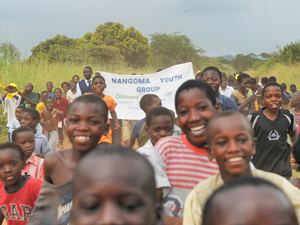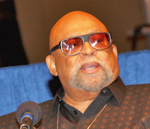Soweto, Simba and African Youth: Young Lions in Life and Struggle
By Dr. Maulana Karenga -Guest Columnist- | Last updated: Jul 7, 2011 - 1:59:24 PMWhat's your opinion on this article?

Children in Nangoma, Zambia celebrate Youth Day.
|
In their heroic rising in revolt against apartheid and taking the lead at a critical moment in the history of the South African liberation movement, they fought not only for a better education for themselves, but also for the right of the South African people to live free and dignity-affirming lives and to forge their future in their own image and interests. Moreover, such an observance also provides us with an excellent opportunity to remember and reaffirm in special ways the essentiality of young people to the good life we all deserve to live, to the lasting legacy we want to leave, and to the transformative struggle we must wage and the hard work we must accomplish to achieve this.

Dr. Maulana Karenga
|
The legacy, lessons and continuing challenge of Soweto are not only of and for South Africa, but also for African people everywhere, especially African youth. For it is about young people choosing to act in the interest of freedom and defining themselves in struggle as a self-conscious component part of the forward thrust of history. This, of course, is the essential meaning and urgent message in Frantz Fanon's classic observation in the midst of the freedom struggles of African peoples on the continent and in the Diaspora that “each generation must out of relative obscurity discover its mission and fulfill it or betray it.” Here Fanon uses the word mission which not only incorporates both the concepts of role and responsibility but also insists on their inseparability in thought and practice. This requires that young people and we of the preceding generations realize that they are not simply our future, but our future unfolding and act accordingly and cooperatively to shape it in the interest of African and human good.
A second critical issue for youth, then, is the role of the preceding generations in shaping and sharing the way young people conceive, cultivate and ultimately live their lives. Mary McLeod Bethune leaves us, as her Ninth Legacy, “a responsibility to our young people,” especially “to direct their (potential and) power toward good ends.” She wants us to teach them that the “world belongs to youth” not in any exclusive generational sense, but because they will inherit it as a legacy from preceding generations and “will take over its future management.” She urges us to teach them to imagine and forge a new future, insist on education for service, and ensure that they “never lose their zeal for building a better world”, a world of freedom, justice, peace, material progress, health and well-being and human solidarity. Their task, then, is to get an education for life, living and liberation, to “enter (the academy) to learn (and) depart to serve,” and “not be discouraged from aspiring toward greatness.”
In a 2008 African Youth Day speech, former President Thabo Mbeki reminded us that then President Oliver Tambo of ANC had called the young students young lions to emphasize their courage and commitment to struggle. And he called on the current generation of youth to be young lions also in forging the future ahead of them. It is a call and work which parallel our own, i.e., continuing cultural revolution, radical social change and bringing good in the world. For in 1965, inspired by the Simba, young freedom fighters in the Congo, and by Malcolm's praise of them and the ancient symbolism of the lion in Africa and world culture, we of the organization Us built one of the most disciplined, radical, ideologically grounded, service-oriented and martially prepared youth groups in the Movement, the Simba Wachanga (The Young Lions).
Our self-conception and self-assertion in the liberation movement was based on five dual commitments which offer a framework for our rebuilding and building a movement of young lions to confront and effectively engage the demands of this historical moment, fighting fervently on various battlefields necessary to secure well-being, wholeness and a worthy future for our people and the world. These dual aspects expressed in the letters of the word SIMBA are commitments to be: (1) a Shield for the people and a Spear against the oppressor; (2) an Inspiration to youth and Innovators in revolution; (3) a Monument to the ancestors and a Movement for liberation; (4) a Brotherhood to ourselves and Builders of our nation; and (5) Advocates of Us and an Alternative to them.
Thus, the essential tasks of the Simba, the Young Lions, were and remain: to be a shield in defense of the interests of the people and active and assertive against all oppressors and all forms of oppression. Simba are also to be a model and mirror for other youth, bring forth the new and valuable in the interest of the struggle, honor the ancestors by living and expanding their legacy, build and rebuild the Movement, strengthen and build brotherhood and sisterhood among themselves; be co-builders of a self-determining and flourishing African community; and self-consciously dare to pose and bring into being a radical alternative to the established order in the interest and enjoyment of freedom, justice and other species of good in the world.
(Dr. Maulana Karenga, Professor of Africana Studies, California State University-Long Beach; Executive Director, African American Cultural Center (Us); Creator of Kwanzaa; and author of Kwanzaa: A Celebration of Family, Community and Culture and Introduction to Black Studies, 4th Edition, www.MaulanaKarenga.org.)
INSIDE STORIES AND REVIEWS
-
-
About Harriett ... and the Negro Hollywood Road Show
By Rabiah Muhammad, Guest Columnist » Full Story -
Skepticism greets Jay-Z, NFL talk of inspiring change
By Bryan 18X Crawford and Richard B. Muhammad The Final Call Newspaper @TheFinalCall » Full Story -
The painful problem of Black girls and suicide
By Charlene Muhammad -National Correspondent- » Full Story -
Exploitation of Innocence - Report: Perceptions, policies hurting Black girls
By Charlene Muhammad -National Correspondent- » Full Story -
Big Ballin: Big ideas fuel a father’s Big Baller Brand and brash business sense
By Bryan Crawford -Contributing Writer- » Full Story






 Click Here Stay Connected!
Click Here Stay Connected!








